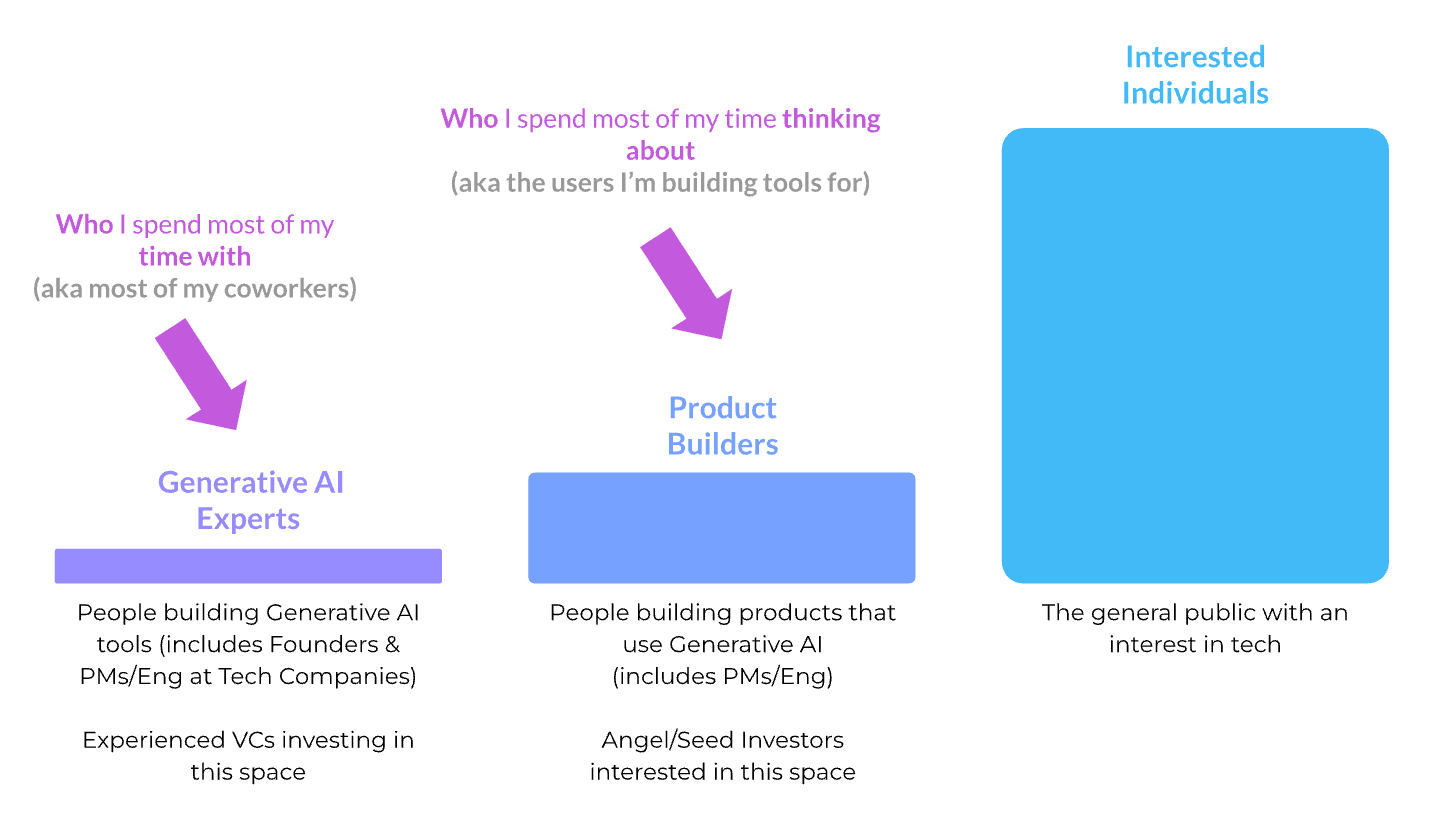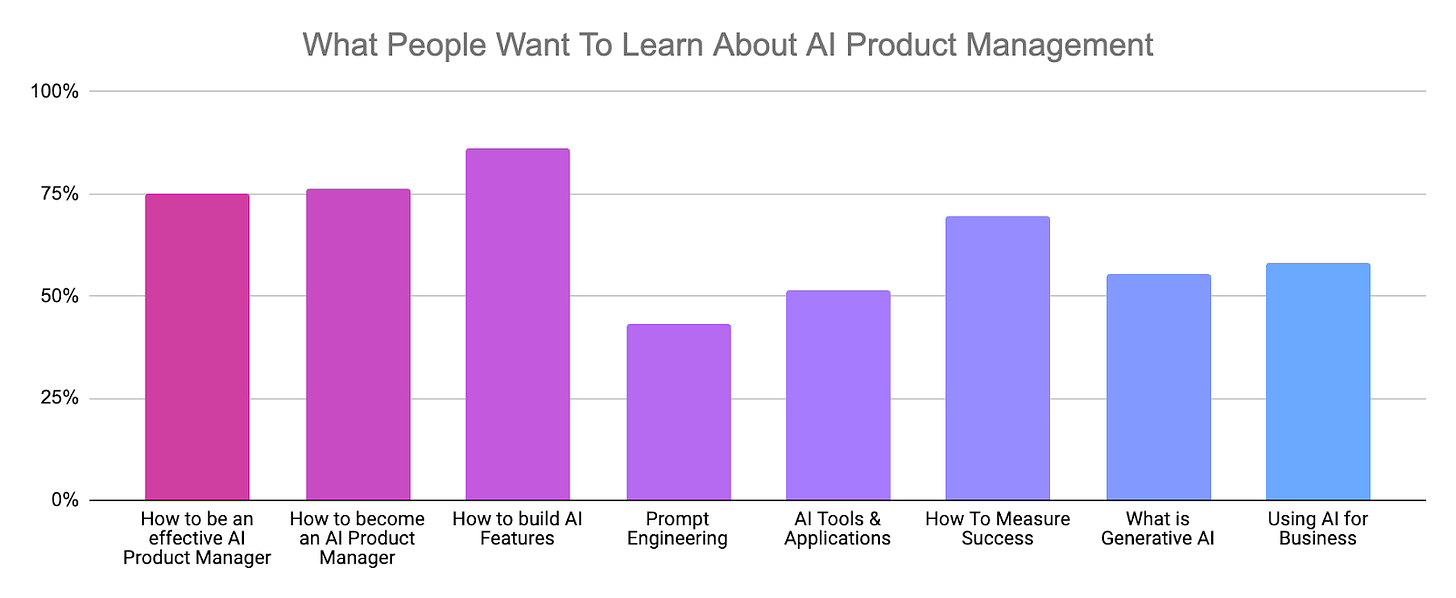4 Unexpected Insights on Generative AI after 72 Surveys, 24 Conversations, and 7 Silicon Valley Events
A Personal Journey Through the Minds of Founders, Investors, and Tech Pioneers
I recently made an effort to attend every interesting Silicon Valley AI tech event that crossed my radar so I could get a sense for how different people were thinking about the state of Generative AI. This included a couple Google events, TED AI, a few OpenAI Dev Day events, and an AngelList happy hour.
Even though I’ve spent the last several years working on AI Products, and with a specific focus on Generative AI for over a year, I haven’t ever really taken a moment to step back and look at things from the outside in. These conversations made me truly appreciate just how fast the industry has been moving, and that my point of view from the inside is very different from those who haven’t spent almost every minute of every day immersed in this domain.
The attendees, and the ensuing discussions, were very diverse. There were founders of all experience levels - ranging from folks just beginning their journey and still honing in on their idea, to those currently in accelerator programs, and even ones who had been working on their company for years. I also spoke with investors of different sizes - from angel and seed investors to partners at VC firms. Some attendees were like me, working in the space - and others were interested in learning more about how to do so.
3 Groups of People
At the end of all these conversations, it felt like people slotted into three main categories:
Generative AI Experts
For the most part these were people who were deeply connected into the space of Generative AI. They were working on solving very specific and difficult problems - things like deploying flexible and secure GraphQL APIs, to using LLMs to dependably make API calls. This is by far the smallest group - their knowledge about the topic is extensive, and I’m excited to learn more about what they are working on since they’re the ones pushing the limits of what’s possible. This was the group I found least surprising but most interesting.
Product Builders
This is the group I have been primarily focused on in my day job - they are the developers, PMs, and founders of product first companies (rather than AI dev tool companies which tended to fall more into the first category of Generative AI Experts). This was the group I was most interested in talking to. I was excited to start digging into how these people were thinking about Generative AI, and discovering what unique and powerful ways they were integrating it into their products and applications to better meet user needs. There are a lot more people in this bucket than in the first, and this is the group that I ended up being most surprised by.
Interested Individuals
This is by far the biggest group out there, and basically contains everyone who is currently interacting with Bard and ChatGPT as their main exposure to Generative AI. Most people here are focused on how to use Generative AI to help them achieve business goals (i.e. write a report or fill out an RFP) and personal tasks (fill out applications for their kids’ school or write an email for a party invitation). This is where most people currently fall - and I encountered a few surprises even within this group.
Top 4 Takeaways
The following are my top 4 takeaways from all the conversations I had with various people across these 3 groups:
#1: People building Generative AI tools are significantly further ahead when it comes to how they think of the space versus everyone else
In retrospect, this isn’t too surprising - this area has been moving fast, and people have barely had time to wrap their head around one amazing advancement before yet another one is announced. There’s a joke that a year’s worth of advancements in Generative AI happened last week – and after talking to people who weren’t already immersed in it, that became incredibly obvious.
This was especially apparent when engaging with the Interested Individuals group (most people). They were primarily still focused on philosophical questions surrounding topics like AI ethics and making sure humanity is building safe and thoughtful AI. While these are topics I believe are important, I was surprised that the conversations weren’t…deeper. I’m specifically thinking about many of the talks at TED AI which left me wanting a lot more substance. AI safety and ethics are important - but it’s time for the conversation to move beyond just talking about this being a problem and towards actually solving it.
#2: Most people still don’t really know how, or even what, to build with Generative AI
I was most surprised by the conversations I had with folks in the Product Builders bucket. I was expecting to hear a diverse set of interesting use cases and compelling ideas; and to learn a bunch from others building products, features, and companies using Generative AI, and how they were thinking of this area. I wanted to know things like - what do they wish Generative AI could do, where is it working best or failing them, and what are new tools and features they wished existed. What I ended up hearing about instead was a lot of ideas that were essentially a ChatGPT for X [therapy, interview prep...], or ways to incorporate ChatGPT-like interactions into an existing product. The good news is that this was accompanied by an overwhelming sense of excitement (which I love) and desire to learn more.
It became apparent to me that we are still very much building the first generation of products, and as a result this isn’t too unexpected. In fact, I recently polled the broader PM community to better understand what they wanted to learn more about - and the results corroborated this - almost 90% of respondents wanted to learn more about how to tactically build AI features:
My two cents: even though ideas on how to use Generative AI right now are pattern matching pretty heavily on the success of ChatGPT, there is undeniable excitement in this space, and it’s only a matter of time before AI-first or AI-native products will emerge that use this technology in non-obvious ways.
#3: It’s about more than just the model
When talking to folks in the AI Experts bucket I started to get an exciting glimpse of things to come, and one thing that really stands out…the future of Generative AI is about way more than just the models. There’s a lot of impressive things happening in the areas of Embeddings and Retrieval Augmented Generation. Approaches like those in the recent Voyager paper go beyond just ReACT and AutoGPT, providing new and interesting ways to think about a problem space. Even the launch of custom GPTs shows the push towards “more than models” - which right now are basically just Prompts + RAG + action packaged up as an agent – something that will seem rudimentary in a few weeks and which will certainly get more mature and powerful over time.
#4: What’s the AI device of the future?
I believe that a new device will emerge - one that puts AI first and is built from scratch with AI at its core: from the hardware and OS level to the actual UX - causing us to rethink our mental model not only of how a device works, but even how we interact with it. Things on my mind right now…
What form factor will resonate best with consumers? At $699 the Humane pin is an interesting take as an early player - although I can’t help but be reminded of the Google prototype inspired by the Star Trek Communicator or the even less successful Google Clips camera. Or maybe AI is what will make glasses finally take off - things can only continue to get better for this form factor. Of course, the talks of Johny Ive and OpenAI spark even more curiosity….
What is the “mobile app” of the AI future? If we’re rethinking the device, then I think it’s only fair to say there’s going to be a rethink of what an AI app is, or at least how it works – will “agents” play into this?
What interaction patterns will emerge? We’re due for a paradigm shift on the chat UX - especially once multi-modal capabilities begin to mature. I’m surprised there are so few companies/products experimenting with novel AI-focused UI patterns that aim toward adaptive yet intuitive experiences (then again, maybe this speaks even more to my takeaway #2 above).
I don’t yet know what this device will be or how it will work - but I’m excited to keep pulling at this thread.
I'm glad that I attended these events and sought out so many conversations. It's always illuminating to step outside your bubble and learn about what other people are working on and how they perceive your industry. I plan to make this a regular habit to check the temperature of the market and to provide my two cents to all of you and your beautiful, curious minds!







Amazing insights!